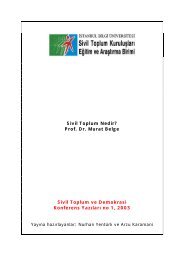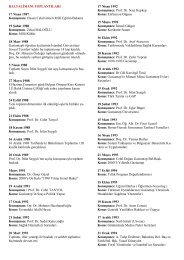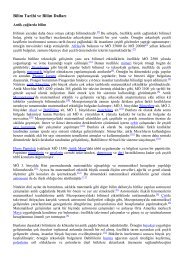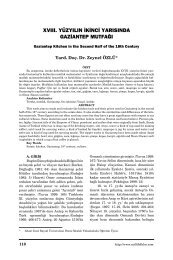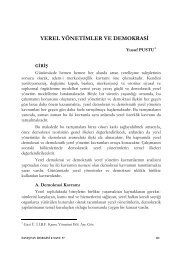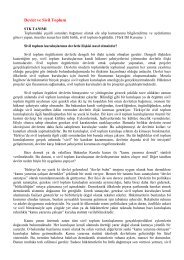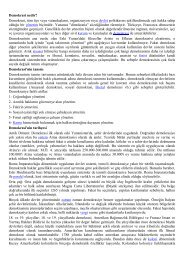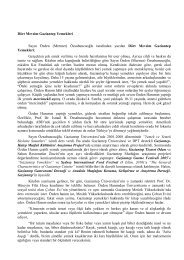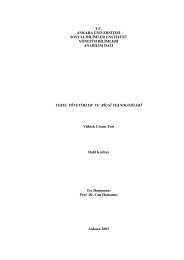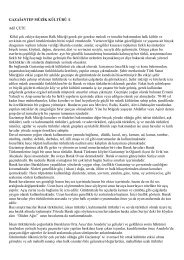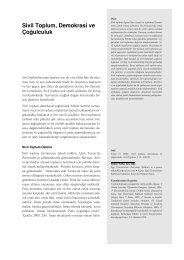Gaziantep'te SanayileÅme ve Toplumsal DeÄiÅme
Gaziantep'te SanayileÅme ve Toplumsal DeÄiÅme
Gaziantep'te SanayileÅme ve Toplumsal DeÄiÅme
Create successful ePaper yourself
Turn your PDF publications into a flip-book with our unique Google optimized e-Paper software.
46<br />
Gaziantep Kırsalında Sanayileşme Ve <strong>Toplumsal</strong> Değişim:<br />
Dülük Köyü Örneği<br />
villagers of their social status and social environment. The findings of this study are<br />
based on 115 household questionnaires and many planned and spontaneous in-depth<br />
interviews conducted with the residents and local notables of the village.<br />
Findings<br />
The data obtained from the fieldwork show that the economic structure of the<br />
village underwent a radical transformation within the past decade as the organized<br />
industrial districts ha<strong>ve</strong> started to locate in the nearby agricultural fields.<br />
Agricultural activity has ceased to be the primary economic activity in the village<br />
and replaced by employment in the industrial enterprises and public service sectors.<br />
The main reason for the radical shift in the economic activity is the fact that the<br />
majority of the villagers sold their fields to the industrial enterprises seeking to<br />
locate in the area. Many of the villagers now ha<strong>ve</strong> no fields. Those who ha<strong>ve</strong> <strong>ve</strong>ry<br />
small lands either stopped cultivating the land or continue to engage in subsistence<br />
agricultural activities. E<strong>ve</strong>n the <strong>ve</strong>ry few large land owners (2 households) do not<br />
rely on agriculture as the sole income generating activity. All the villagers ha<strong>ve</strong> at<br />
least one wage-earner in the family. Many solely depend on waged employment in<br />
these private industrial enterprises around the area and public institutions in the city.<br />
In other words, the majority of villagers ha<strong>ve</strong> become proletarians and some public<br />
servants. Howe<strong>ve</strong>r, since proletarization has not invol<strong>ve</strong>d a mo<strong>ve</strong>ment in space<br />
(rural to urban migration) and forced a radical change in lifestyle, agricultural<br />
activities continue to be engaged as additional source of income by many<br />
households. In that sense, perhaps, we can call the villagers as “proletarian<br />
peasants.” In addition, proletarization has been mainly limited to men. Although<br />
working in industrial enterprises has become the main form of employment in the<br />
village, there are no women employed outside of the household as wage-earner.<br />
Women ha<strong>ve</strong> become “housewi<strong>ve</strong>s” as frequently addressed in the studies on the<br />
poor peasants’ migration to urban centers in Turkey.<br />
The study also obser<strong>ve</strong>d that, similar to the studies on modernization and<br />
industrialization, in the village the household size and structure ha<strong>ve</strong> been changing<br />
towards small nuclear families. The families also modernized their housings<br />
imitating the urban forms of multiple storey buildings. The apartments usually<br />
consist of a guest room, separate kitchen, bedrooms, separate bathrooms and toilets<br />
inside as is the case in urban dwellings. Howe<strong>ve</strong>r, the unique condition of the<br />
village has limited the force of modernization both in the size of households and<br />
type of dwellings. There are many extended households who are forced to li<strong>ve</strong> in<br />
old and small dwellings together with married children and grandkids. Howe<strong>ve</strong>r,<br />
this type of living is seen as undesirable by almost e<strong>ve</strong>rybody in the village and<br />
nuclear family lifestyle has been accepted as a norm. All of the newly-wed couples<br />
desired to mo<strong>ve</strong> into their separate dwellings when it becomes possible.<br />
One of the significant findings of the study is about the changing indicators of<br />
education in the village. In contrast to what modernization studies argued, the<br />
demand and le<strong>ve</strong>l of education in the village ha<strong>ve</strong> not increased following



